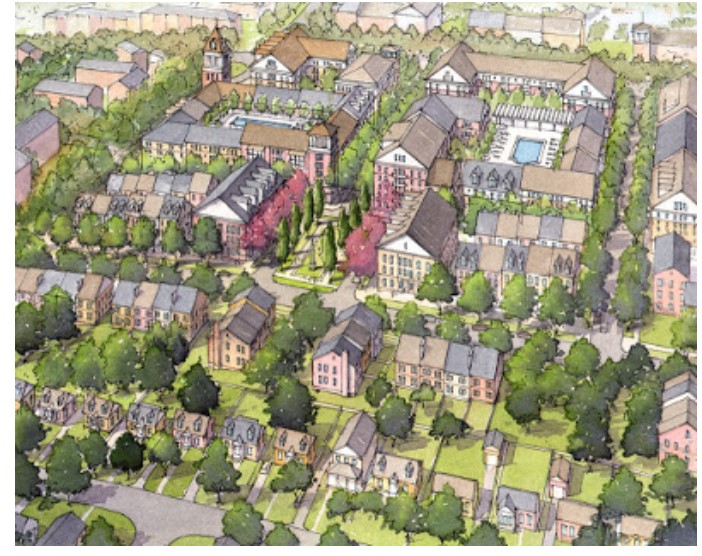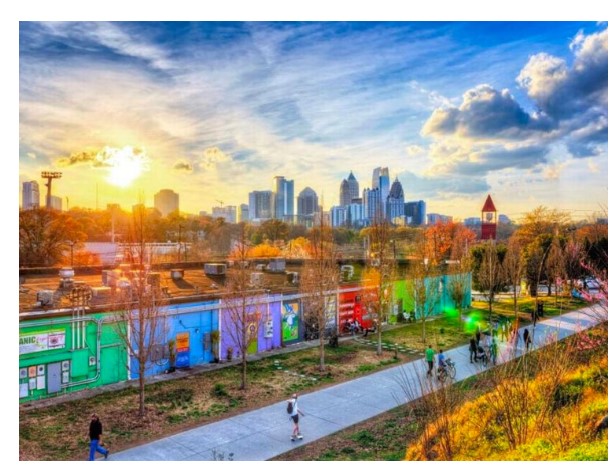Harrison Burnside
Riya Patel
AP Human Geography 🚜
320 resourcesSee Units
New Urbanism
New Urbanism is a counter to urban sprawl.
For review, urban sprawl refers to the expansion of cities and urban areas into surrounding rural or undeveloped land. It is characterized by low-density development, with a proliferation of single-family homes, strip malls, and other automobile-oriented development. Urban sprawl can have a number of negative impacts, including:
- Increased traffic and air pollution: Urban sprawl can lead to increased car use, which can contribute to air pollution and traffic congestion.
- Loss of natural and agricultural land: Urban sprawl can result in the loss of natural and agricultural land to development, which can have negative ecological and economic impacts.
- Increased infrastructure costs: The spread of urban development over a larger area can require significant investments in infrastructure, such as roads, water and sewage systems, and other utilities.
- Social and economic segregation: Urban sprawl can contribute to social and economic segregation, as different income groups often live in different areas and may not have access to the same resources and opportunities.
- Decreased quality of life: Urban sprawl can lead to a decrease in the quality of life in a number of ways, including by reducing access to green space and recreational opportunities and increasing the time and cost of commuting.
Urban Sprawl came about in the automobile era from Detroit, MI. Before this era, cities were built in walking-distances and there was less development. Then, when the automobile was invented, cities grew "up" and the city itself instead grew "out".
The widespread adoption of the automobile in the 20th century had a major impact on the way cities developed and grew. Prior to the automobile era, cities were typically more compact and were designed for pedestrian access, with a mix of land uses and a range of housing types.
With the rise of the automobile, cities began to spread out and develop in more low-density, single-use patterns. This trend was driven in part by the availability of cheap land on the outskirts of cities, as well as by the desire of many people to own their own single-family homes and to have easy access to their cars.
As a result, many cities experienced urban sprawl, with the expansion of low-density, automobile-oriented development into surrounding rural or undeveloped areas. This pattern of development has had a number of negative impacts, including increased traffic and air pollution, loss of natural and agricultural land, and decreased quality of life in many urban areas.
Development, urban revitalization, and suburban reforms can create walkable neighborhoods that have a diversity of housing and jobs. New urbanists seek to make neighborhoods that promote a sense of place.
Urban Revitalization
Urban revitalization refers to the process of renewing and revitalizing urban areas that have declined or are in need of improvement. This can involve a variety of activities, such as improving physical infrastructure, attracting new businesses and investment, and promoting cultural and recreational amenities.
Urban revitalization can be driven by a variety of factors, including the desire to improve the quality of life for residents, to increase economic development and job opportunities, and to attract tourists and other visitors. It can also be motivated by a desire to address social and economic inequalities and to create more inclusive and equitable communities.
There are many different approaches to urban revitalization, and the specific strategies and policies used can vary depending on the needs and goals of a particular community. Some common strategies for urban revitalization include:
- Physical improvements: This can include investments in infrastructure, such as roads, parks, and public facilities, as well as efforts to improve the appearance and attractiveness of urban areas.
- Economic development: This can involve attracting new businesses and investment, providing incentives for business growth, and supporting entrepreneurship and small businesses.
- Cultural and recreational amenities: This can involve promoting cultural events and attractions, improving access to recreational facilities and green space, and enhancing the overall livability of urban areas.
- Social and community development: This can involve initiatives to address social and economic inequalities, such as affordable housing programs, job training and education programs, and community engagement and empowerment initiatives.
A sample new urbanist community is created with a central shopping center clustered around by a few neighborhoods, usually high rise apartments. New urbanists aim to take up less space.
New Urbanists
New urbanism is a planning and design approach that seeks to create more livable, sustainable, and equitable communities by focusing on the principles of walkability, mixed-use development, and a human-scaled built environment. New urbanism is based on the idea that traditional, walkable, mixed-use communities are more livable, healthy, and economically vibrant than the suburban sprawl that has characterized much of post-World War II development in the United States.
New urbanist planning and design principles are focused on creating compact, mixed-use, pedestrian-friendly communities that are connected to the surrounding region. This can involve the use of traditional neighborhood design principles, such as narrow streets, small blocks, and a mix of housing types and land uses.
New urbanism is often associated with the development of traditional town centers and the revitalization of existing urban areas, and it has been applied in a variety of contexts, from small towns to large metropolitan regions.
New urbanists are individuals who advocate for and promote the principles of new urbanism in planning and design. This can include planners, architects, developers, and other professionals, as well as community organizers and advocates.
The design of new urban neighborhoods has an emphasis on beauty, comfort, and sense of place. There is a public space at the center of the community for public interaction in the shopping center area. The rest of the neighborhood's grid patterned roads are lined with sidewalks for walking easily around the area. These neighborhoods are created using transect planning, meaning that as you move out from the center, the density decreases. New urban communities have a lower environmental impact with less driving and energy efficient buildings.
Some examples of new urbanism projects include:
- Seaside, Florida: Seaside is a planned community on the Florida panhandle that was one of the first and most well-known new urbanism projects. It was designed to create a walkable, mixed-use community with a traditional town center and a range of housing options.
- Kentlands, Maryland: Kentlands is a planned community in the suburbs of Washington, D.C. that was designed to create a more livable and walkable environment by incorporating a mix of housing types, a town center, and a network of pedestrian-friendly streets.
- Celebration, Florida: Celebration is a planned community near Orlando that was developed by the Walt Disney Company and is based on the principles of new urbanism. It features a mix of housing types, a town center, and a network of pedestrian-friendly streets and paths.
- Haarlemmermeer, Netherlands: Haarlemmermeer is a new urbanist development near Amsterdam that was designed to create a more sustainable and livable community by incorporating a mix of housing types, a town center, and a network of pedestrian-friendly streets and paths.

Green Belts
A green belt is a designated area of land around a city or urban area that is protected from development in order to preserve open space, reduce urban sprawl, and promote sustainable land use. Green belts can take many forms, including parks, agricultural land, and natural areas, and they can be managed by various levels of government or private organizations.
Green belts can serve a variety of purposes, including:
- Preserving open space and natural habitats: Green belts can help to protect natural areas and wildlife habitats within urban areas, providing important ecological and recreational benefits.
- Reducing urban sprawl: By limiting development in designated areas, green belts can help to reduce the spread of urban development and encourage more compact and efficient land use.
- Improving air quality: Green belts can help to absorb pollution and reduce the urban heat island effect, improving air quality and making cities more livable.
- Providing recreational opportunities: Green belts can provide recreational opportunities such as hiking, biking, and picnicking, and can be important resources for physical and mental health.
Green belts can be an important tool for promoting sustainable land use and urban development, and many cities around the world have established green belts as part of their planning and development strategies.
One example of a green belt is the M25 motorway in the United Kingdom, which encircles the greater London area. This green belt was established in the 1950s to prevent London from expanding and to protect the countryside from development. It has since been expanded and now covers an area of approximately 4,000 square miles.
The M25 green belt is managed by the UK government and is protected from development, with strict planning controls in place to prevent new building or land use changes. It is composed of a mix of agricultural land, natural areas, and recreational spaces, and is home to a wide range of plant and animal species.
The M25 green belt has been credited with helping to reduce urban sprawl around London and with protecting valuable agricultural land and natural habitats. It also provides important recreational and amenity value for the millions of people who live in the greater London area.
Here are a few more examples of green belts around the world:
- The Greater Toronto Greenbelt in Ontario, Canada is a protected area of approximately 2 million acres that surrounds the Toronto metropolitan region. It was established in 2005 and is designed to preserve natural and agricultural areas, reduce urban sprawl, and promote sustainable land use.
- The Metropolitan Green Belt in the United Kingdom is a protected area that encircles the greater London area and is designed to prevent urban sprawl and preserve the countryside. It was established in the 1930s and now covers an area of approximately 4,000 square miles.
- The Emerald Necklace in Boston, Massachusetts is a system of parks, green spaces, and natural areas that encircles the city. It was designed in the late 19th century by landscape architect Frederick Law Olmsted and includes a number of iconic parks such as the Boston Common and the Arnold Arboretum.
- The Green Belt of China is a system of protected areas that surrounds the Beijing metropolitan region and is designed to protect natural and agricultural land, reduce urban sprawl, and improve environmental quality. It covers an area of approximately 110,000 square miles and is home to a wide range of plant and animal species.

Browse Study Guides By Unit
🗺Unit 1 – Thinking Geographically
👪Unit 2 – Population & Migration
🕌Unit 3 – Cultural Geography
🗳Unit 4 – Political Geography
👨🌾Unit 5 – Agriculture & Rural Land-Use
🌇Unit 6 – Cities & Urban Land-Use
💸Unit 7 – Industrial & Economic Development
🧐Exam Skills
📚Study Tools

Fiveable
Resources
© 2025 Fiveable Inc. All rights reserved.